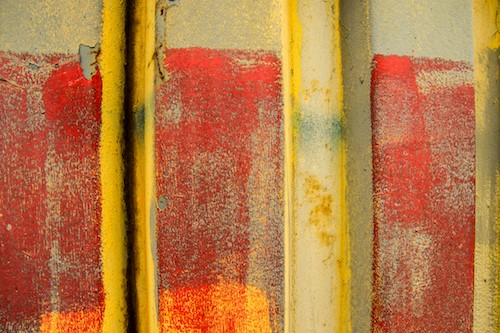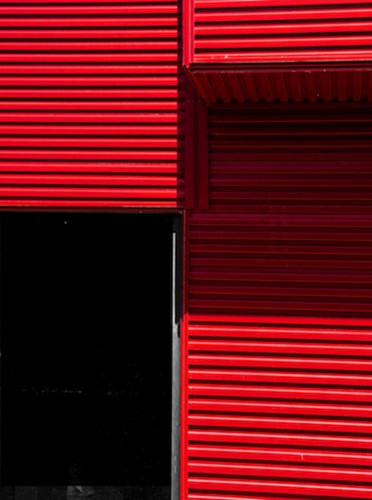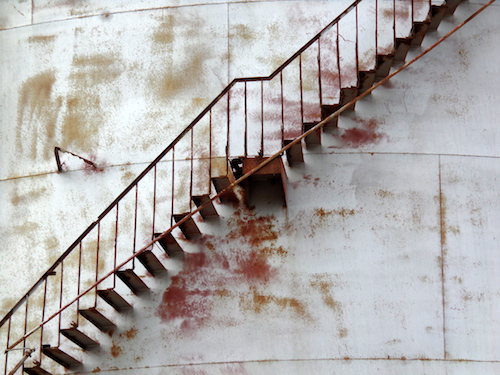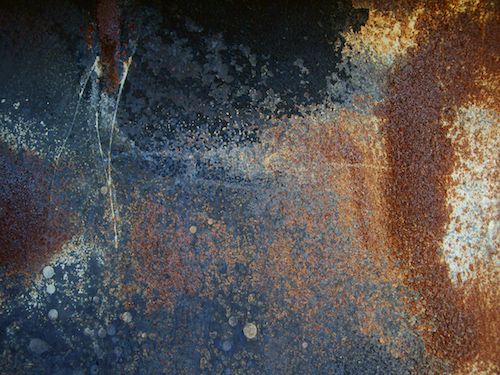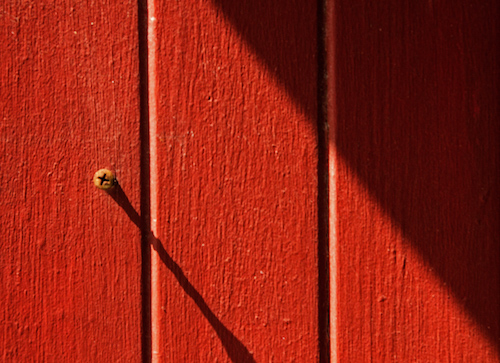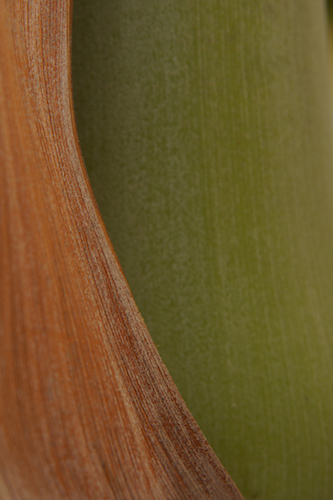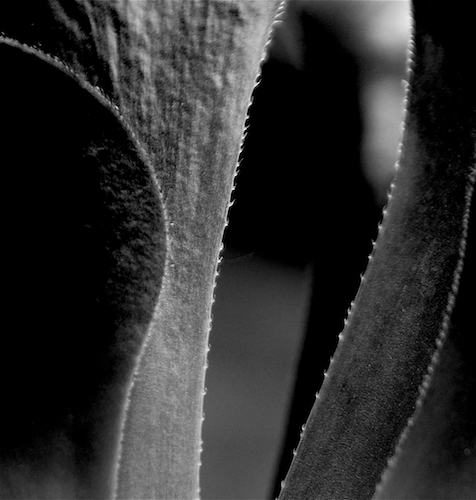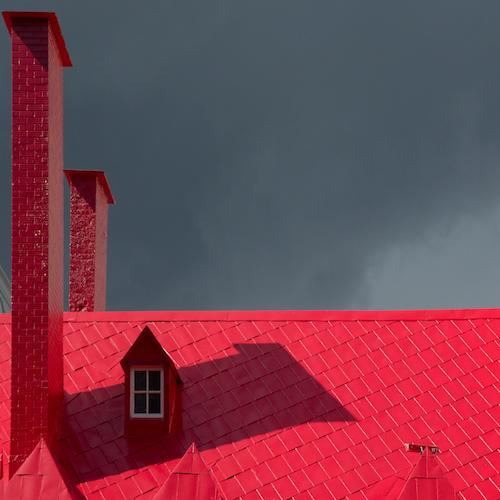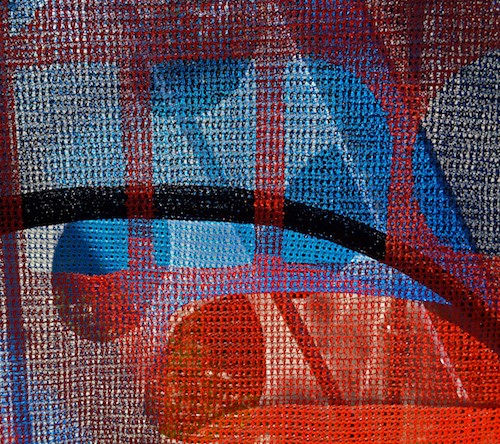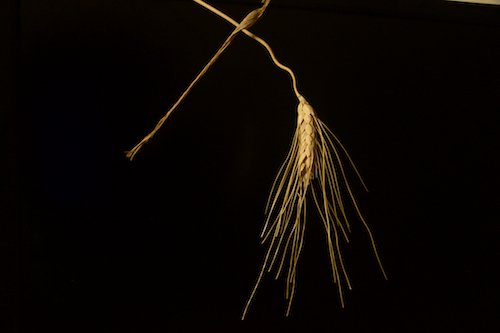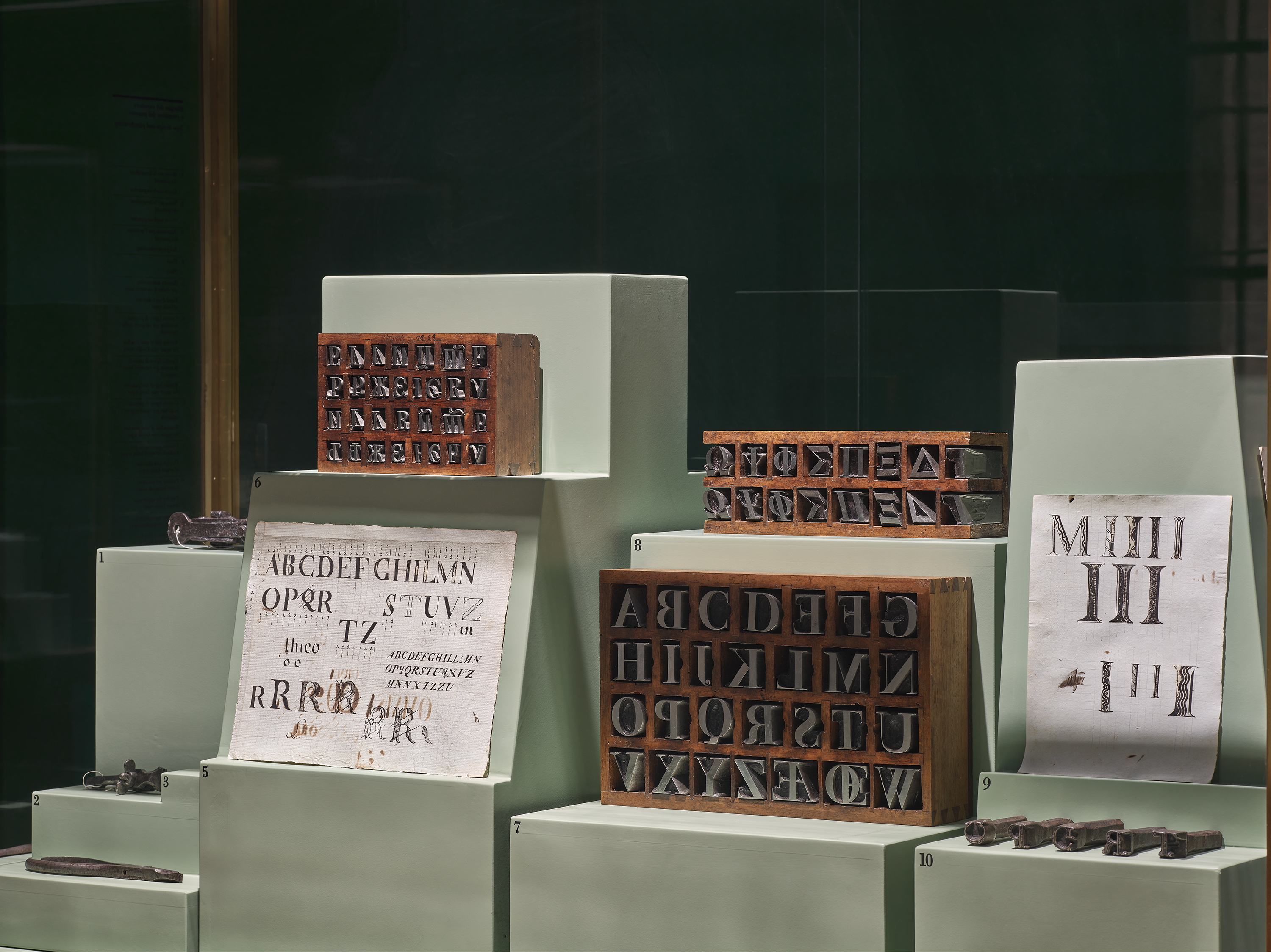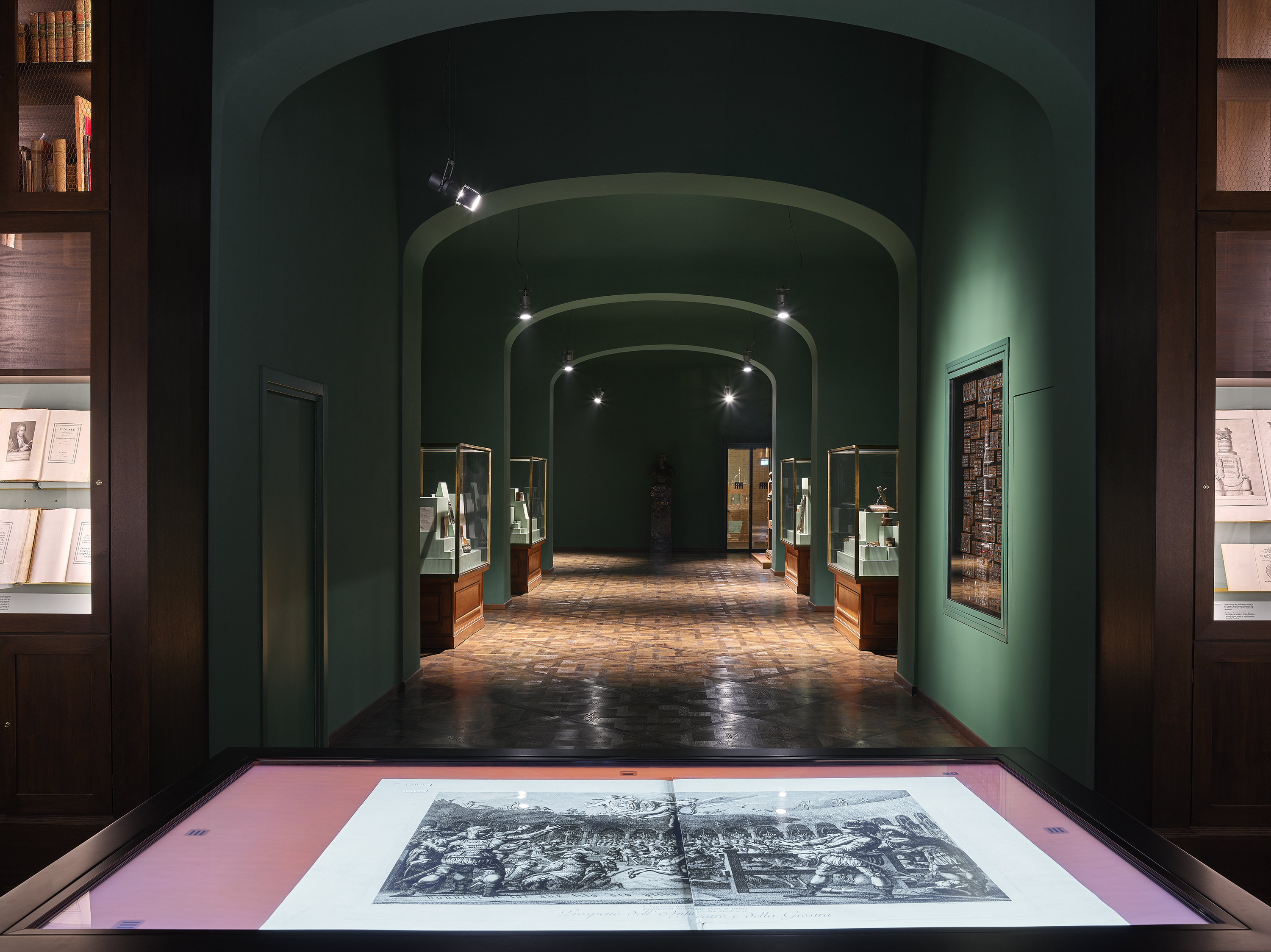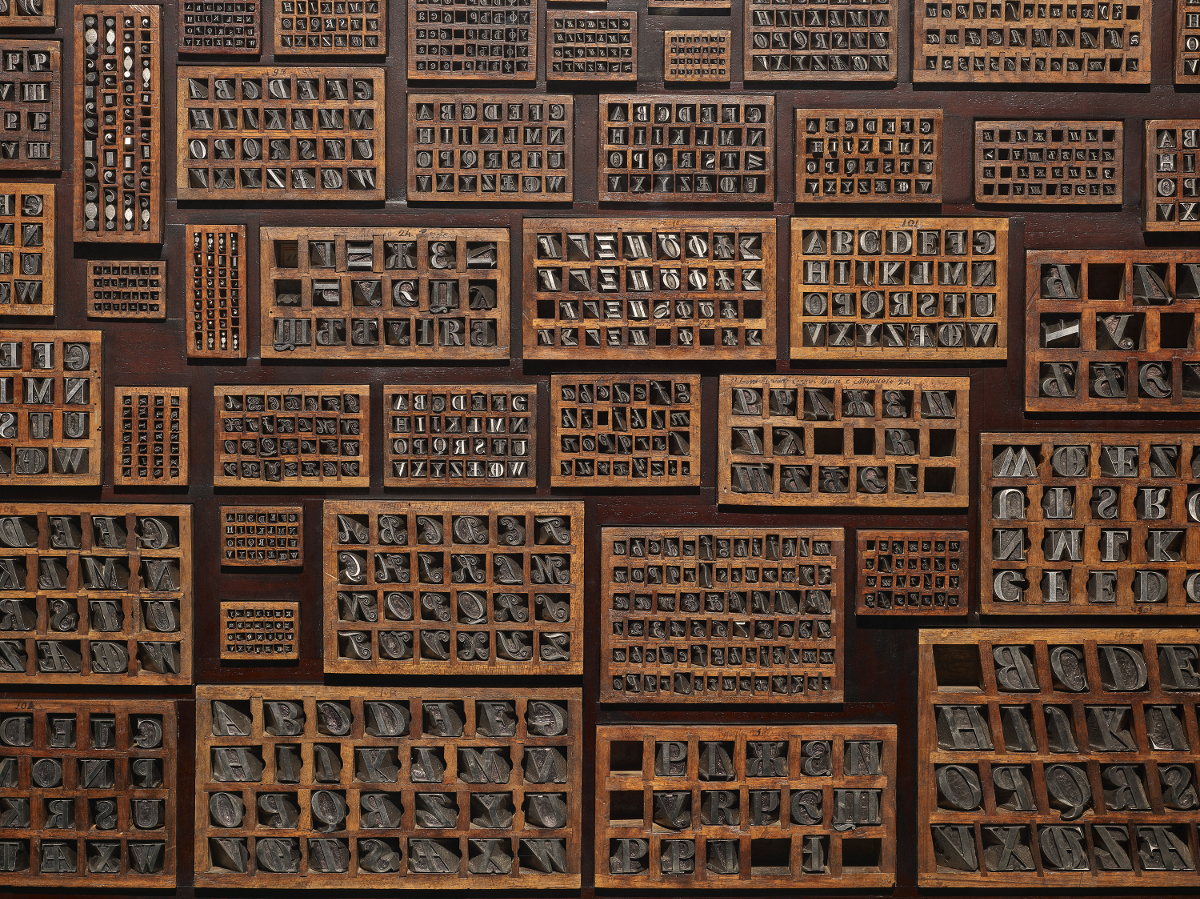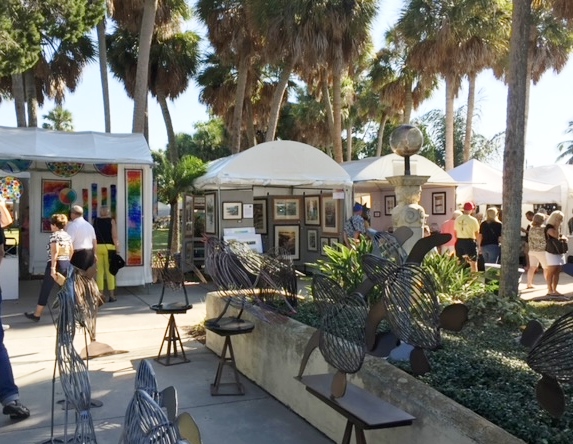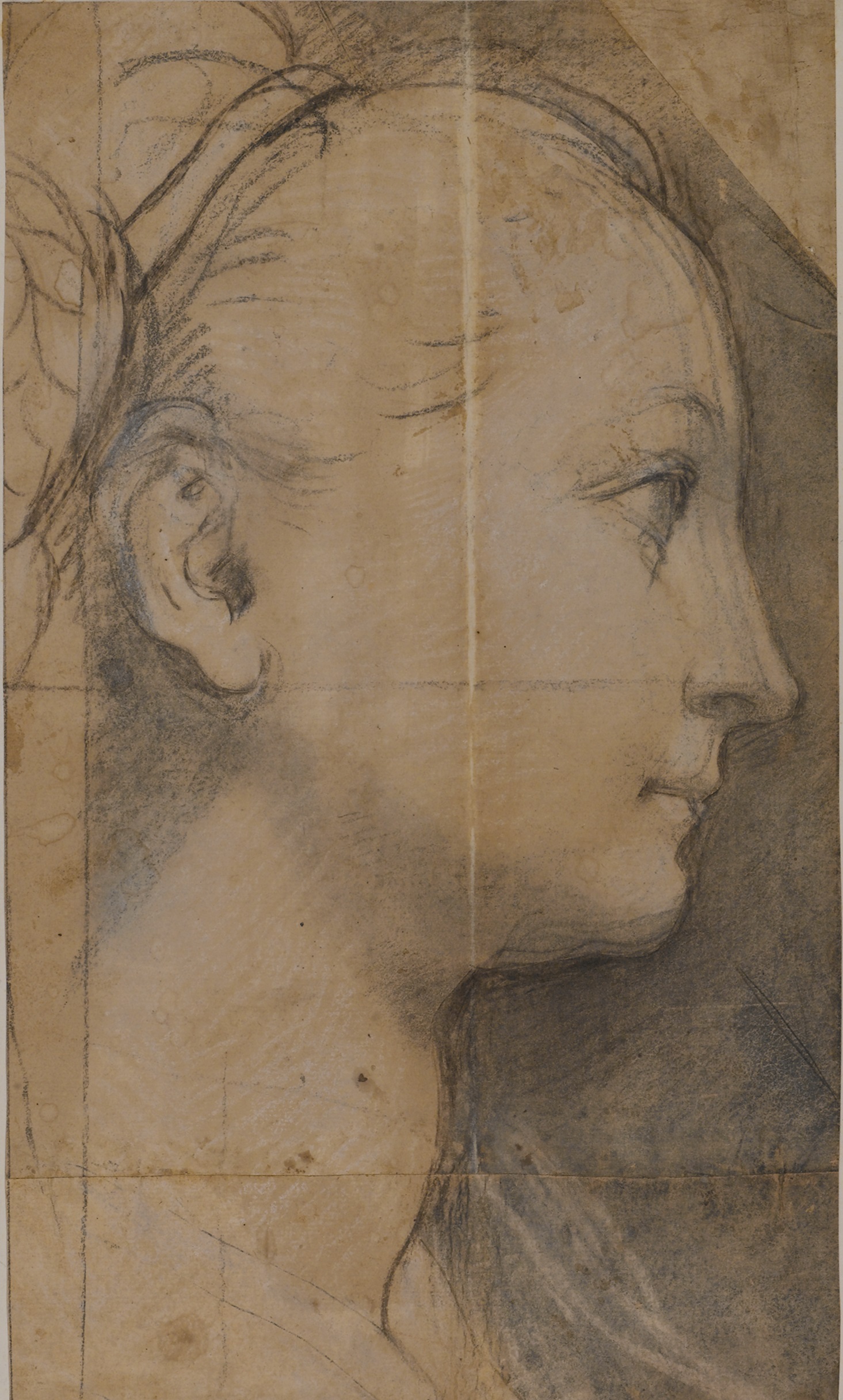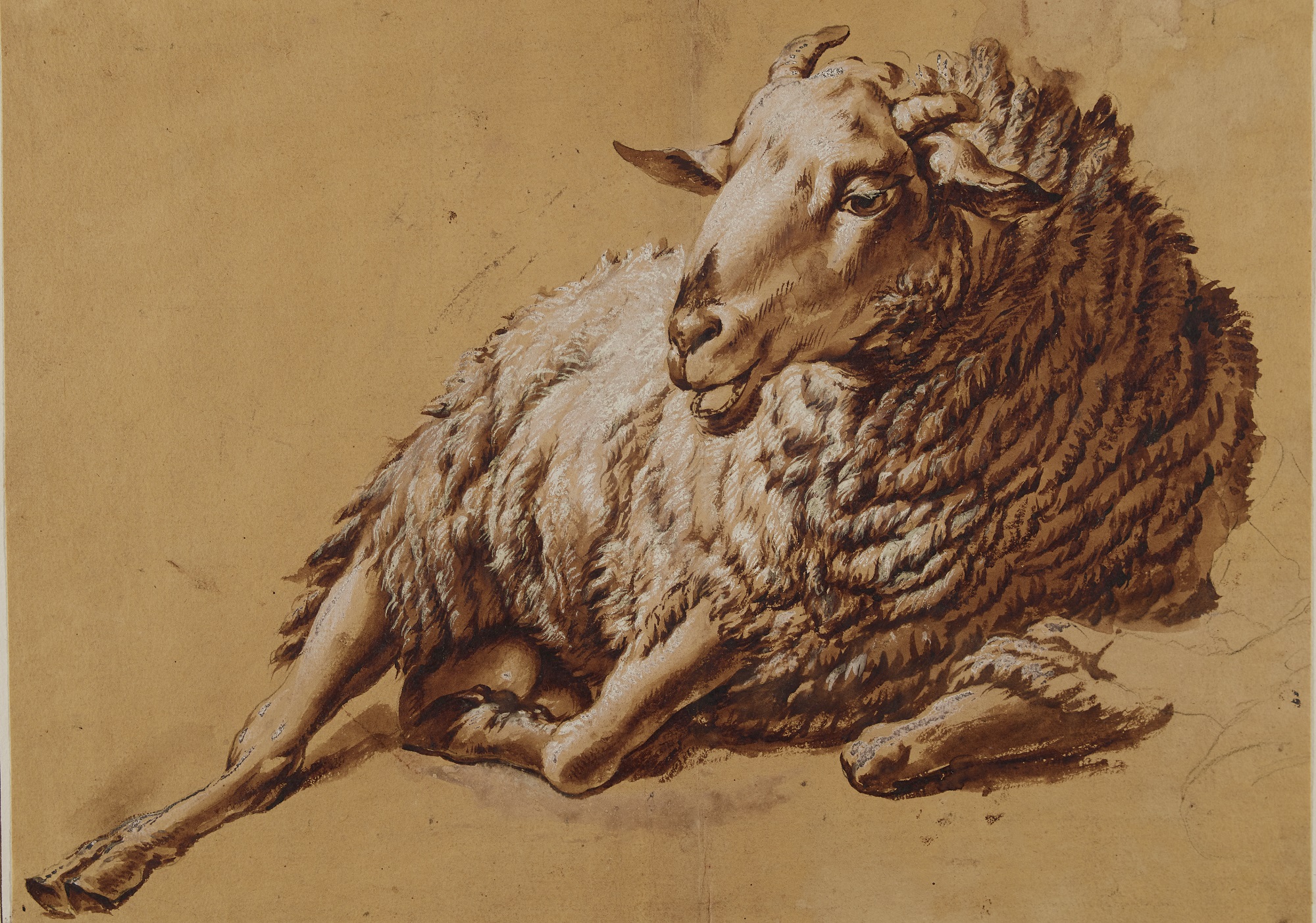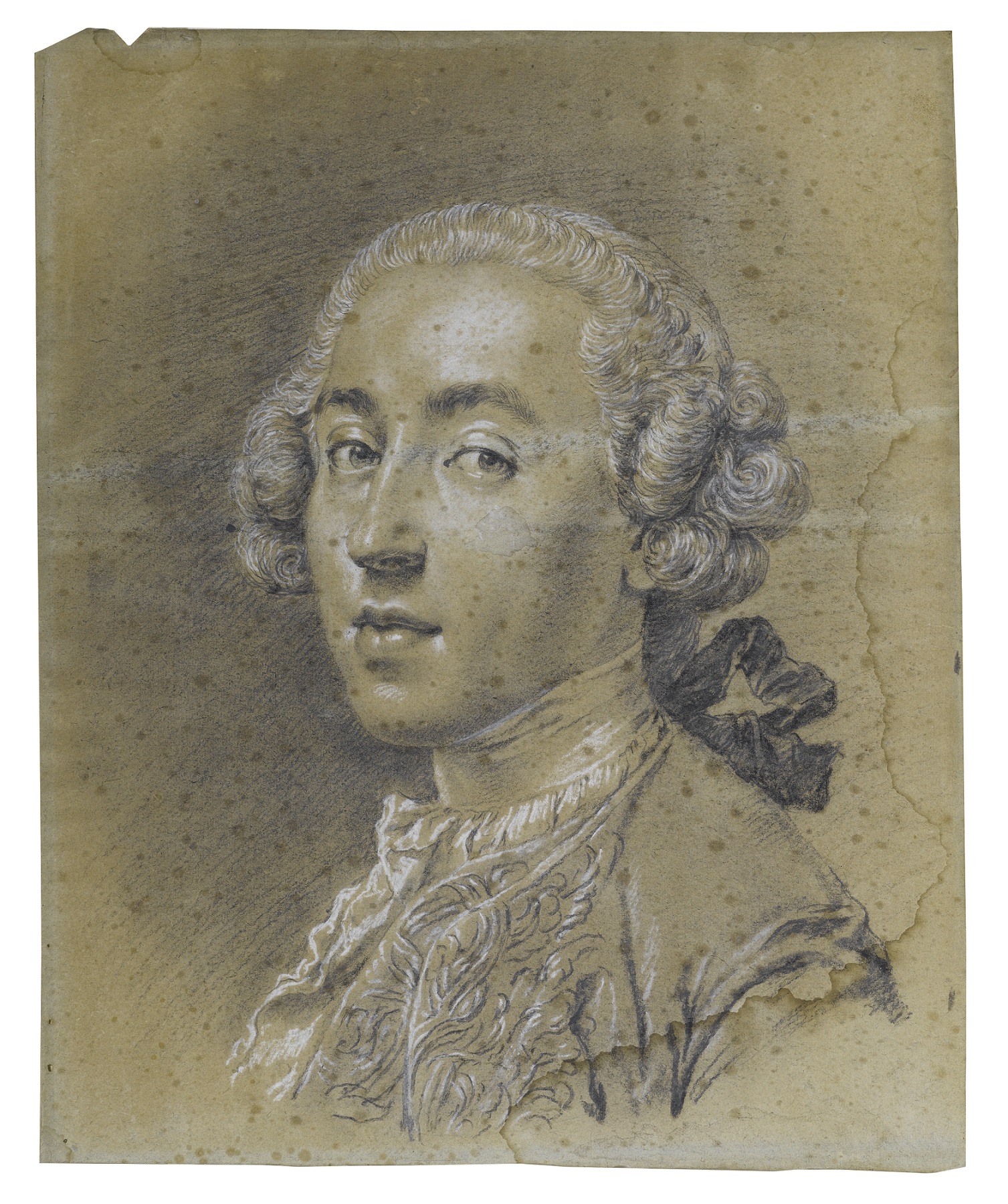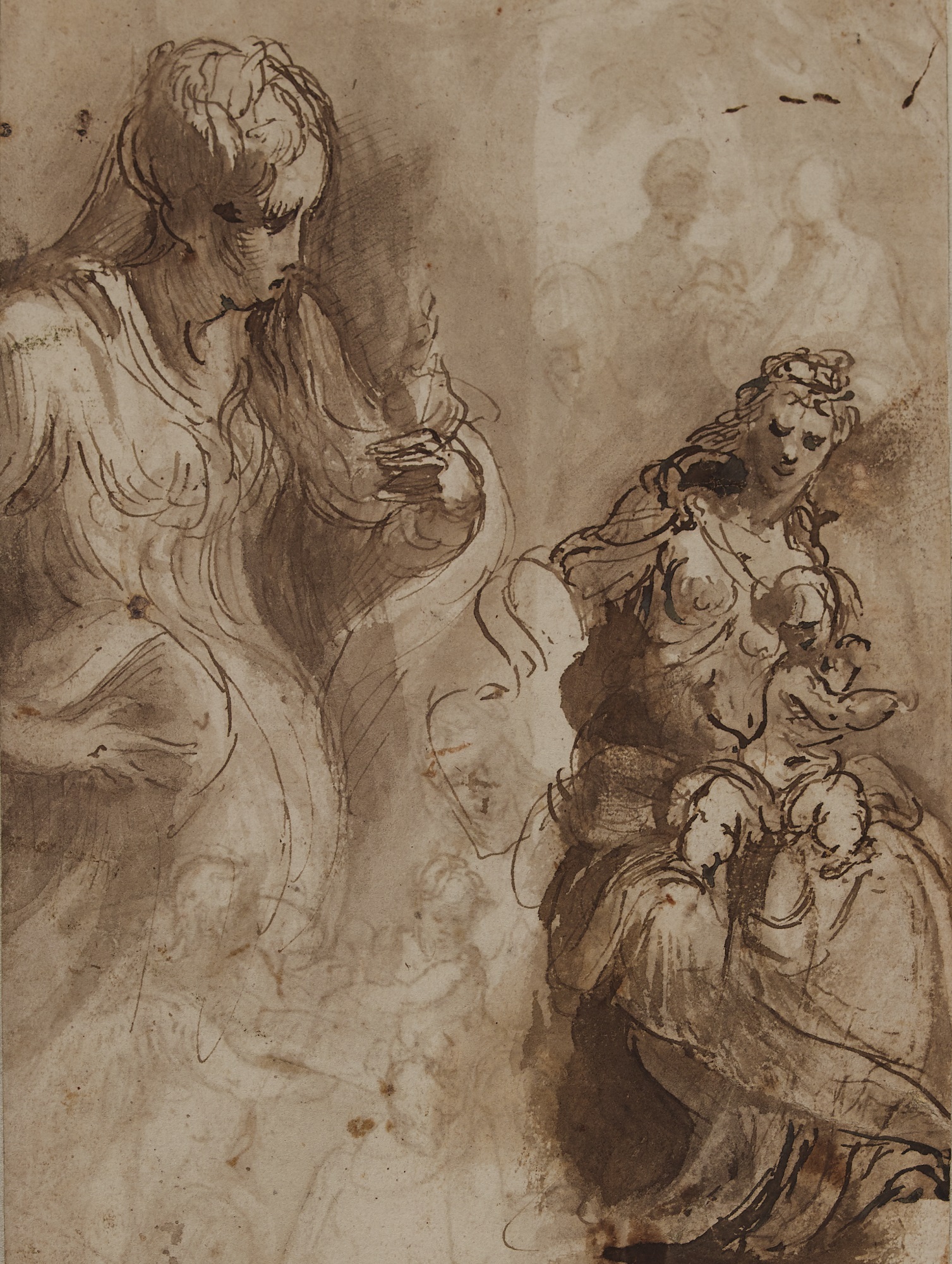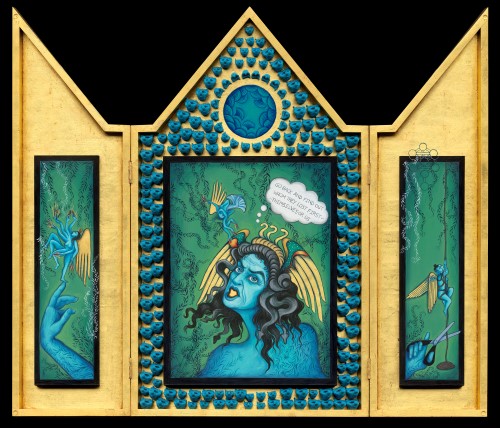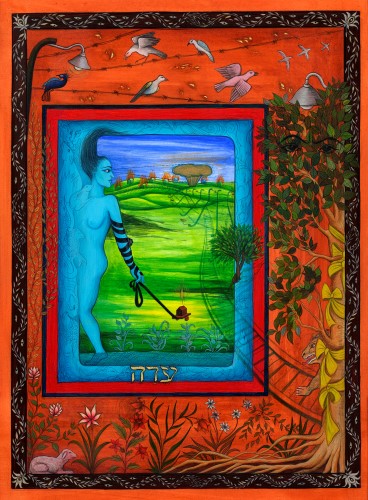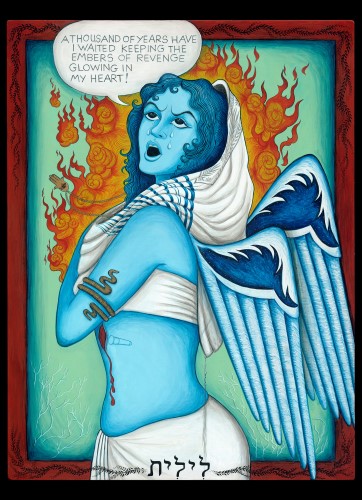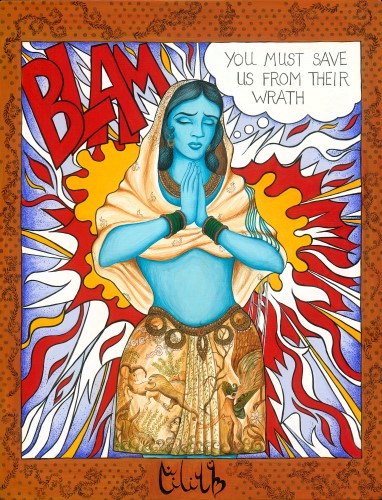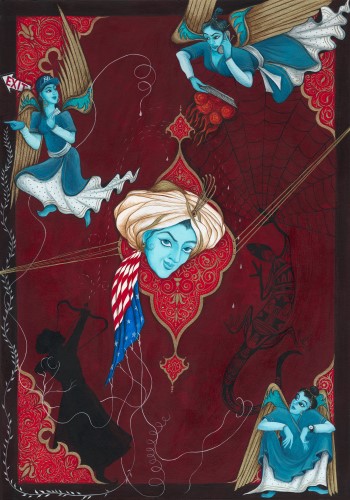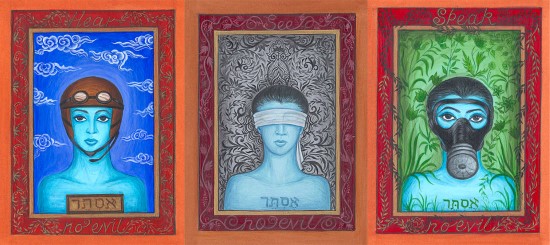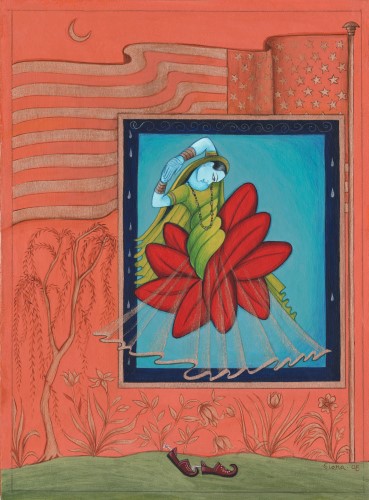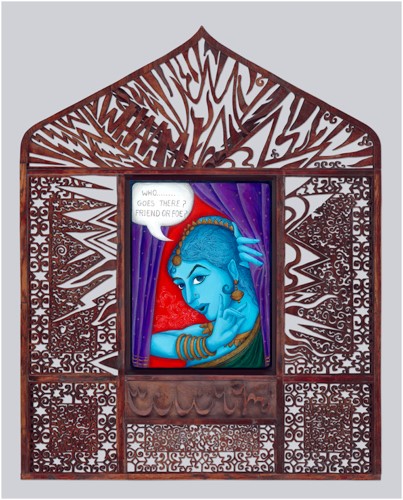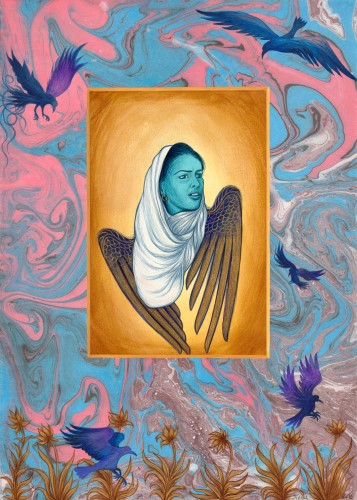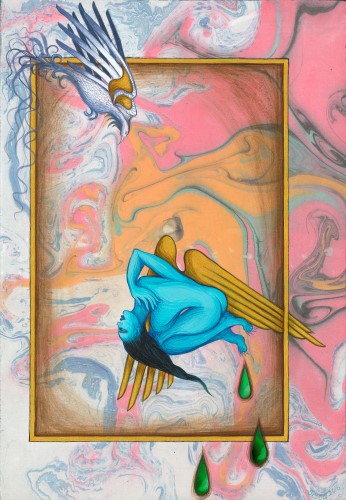Looking from a distance at Untitled (2022), a small painting on wood that does not seem to show anything but scribbles in white paint mixed with some traces of black, orange, and yellow, you might imagine Robert Ryman’s never-ending endgame of painting in all variations of white. But if you come closer, this association proves to be inappropriate. Instead of Ryman’s allover color application in pure gestures, one discovers in the arbitrary squiggles and scribbles a bouquet of flowers, and, sprinkled over them like pollen, fine particles of aluminum glitter that also don’t quite fit into a neo-avant-garde-like position. Upon even closer inspection of the small picture, the size of a sheet of paper, it is revealed that the traces of fluorescent orange and yellow are not applied to the surface but rather emerging from the ground of the painting, in the places where the scribbles erode the white paint to such an extent that a colored background becomes visible, revealed in delicate lines vaguely defining the contours of petals and stems.
Nora Kapfer’s little painting hung at the very beginning of her recent solo exhibition at Kunsthalle Friart in Fribourg, Switzerland. Its adjacency to significantly larger (in comparison gigantic) paintings, each of which produces completely different visual effects, nipped any association of painting’s endgame in the bud. Black-brown, partly reflective, partly matte surfaces in which stenciled contours emerge (Küriss [2018], Untitled (Salami II) [2017]) alternated with color fields overgrown by stenciled flowers in a half-regular, half-irregular manner (Pythia I and Pythia II [2022]). Here, motivic banality met painterly pathos (Dein Herz/Dein Garten [Your Heart/Your Garden, 2022]), the decorative met the resistant, the mechanical met the gestural, figuration met abstraction, and nonorganic forms alternated with organic ones. At the very end of the sequence of paintings hung another small-format wood panel, this time in black, with comparable flower doodles, from which the colored background partially emerges in thin lines. By bracketing the sequence of large paintings with much smaller white and black panels—two works that demonstrate a fast, uncontrolled painterly production, comparable to sketches—Kapfer suggested that the works in between are likewise about making and letting the painting emerge from its material.
What is special about this emergence is that Kapfer’s process of making is always defined by opposing procedures of unmaking. The earliest works presented at Friart were Untitled (Salami) (2017), Untitled (Salami II) (2017), and Küriss (2018), in which Kapfer developed a mechanical technique based on the application of bitumen, a tar-like liquid black substance, over the picture ground to give it a reflective surface, into which the artist glued large silhouettes of flowers made of Japanese paper that soaked up the oily stuff. The organic structure of these papers indeed suggests the surface of a sliced salami—hence the curious title. Or is Kapfer humorously alluding here to her “salami tactics,” a policy of small steps to master the great maneuver of painting, of which she once almost despaired? In other paintings (not exhibited in Fribourg), flowers and other banal and kitschy motifs (hearts, stars, stylized figures) were applied as paper shapes into the bitumen layer only to be taken out again, leaving visible traces of the stenciled silhouettes.
Küriss bears no recognizable motif on its surface, but the black bitumen was partially scraped off the wood with the help of solvent to visually cut out checkerboard patterns and carefully stenciled circles as well as organic shapes; these stand out against the black fields and have been partly covered again with vinyl. The mechanical processes of applying bitumen, cutting out stencils, gluing on paper cutouts, painting them over with oil or vinyl, and scratching the paint off again overlap with an auto-generative chemical process caused by the bitumen’s reaction with different layers of the painting, giving the surface an organic-looking texture in some places. Of course, well-known procedures of a quasi-photographic écriture automatique are recalled here, but they are recombined with further modernist and postmodernist elements of painting such as the grid, the stencil, the pictorial gesture, the figurative cliché, et cetera.
Grids, stencils, and flower clichés also underlie Pythia I and II, painted in gouache, acrylic, and oil on canvas. Here, the largely mechanical, grid-like arrangement of color fields into which flower stencils are serially inserted was supplemented by a rather painterly process. The flowers directly cite Andy Warhol’s Flowers and refer to his Do It Yourself series from 1962, which involved the mechanical filling in of fields according to a numerical code. But while Warhol’s Flowers expose the arbitrariness of color and its commercial use, and his paint-by-numbers series insist on dull mechanical codes, Kapfer’s “paint-by-flowers” works apply a somewhat gestural style by filling the stenciled fields with visible brushstrokes in expressive red or fleshy rosy colors, thereby undoing the mechanical effect of the serialized forms, especially when irregularities break the serial pattern.
Finally, to make works such us Untitled (Oleander III) (2021),Kapfer recycled paper cuts torn off of other paintings, gluing and juxtaposing them in their partly fragmented forms. The overlapping shapes of paper flowers are still marked by the structure of the canvas on which they were previously pasted, and thus produce an organic-like texture, although they just convey the material traces of their mechanical transfer. With a similar effect, Dein Herz, Dein Garten (Your Heart/Your Garden, 2022)recycles flowers cut out of another painted canvas and fixed with acrylic glue on the surface of the new canvas, thereby creating an overpainted, relief-like structure.
Painting, in Kapfer’s selection of works for Friart, presents itself as a complex layering of materials and existing archetypes (grids, figure-ground relations, monochromes, stencils), which either keep “working” independently by chemically and materially infiltrating each other, or are “counteracted” by the artist manually undoing the layering through partial removal, scraping, scratching, tearing off. In the acrylic and oil paintings on canvas, it is rather the gestural application of paint that runs counter to the mechanical composition of the picture and the serial stenciling of banal flowers.
Also in the painterly doodles of the small wood panels, the uncontrolled scribbling of the artist’s tool lays bare colored paper grounds, thereby demonstrating the material agency in the creation of figuration. The motif here appears to be just a side effect of the artist’s handling. Kapfer explicitly links those little paintings to reverse engineering, as invoked by the cultural theorist and philosopher Sadie Plant in her 1997 book Zeros + Ones: Digital Women and the New Technoculture.1 Plantrelates reverse engineering, a “process of analyzing a subject system to identify the system’s components and their interrelationships and create representations of the system in another form or at a higher level of abstraction,” to processes and discoveries by Ada Lovelace and Anna Freud.2 She describes Freud’s ability to accelerate her work—the writing of letters and lectures—by producing scribbles on blank pages at high speed, which induced her to perceive her tasks as already completed. She then more easily turned to the real writing, having simplified it to a system of anticipatory principles and methods. This technique of “beginning in the end of any operation, working backwards from that point to the beginning,” Plant claims, contains within it an “invention of invention itself,” thus contradicting the classic stereotype of femininity that pervades psychoanalysis, in which female creativity is always based on the imitation of the natural.3
In exactly this sense, Kapfer’s white and black wooden panels, tellingly each the size of a sheet of paper, can be read as inventions of the invention. Like catalysts in which the artist works her way back to the ground from the multiple layering of colored papers and white or black oil paint in rapid movements that are as uncontrolled as possible, they release the principles of a way of working that can then be further developed in the large paintings. In the same way hackers use reverse engineering “and pirates conspire to lure the future to their side,” as Plant puts it, Kapfer pirates both expressionist and mechanical models of painting by “engaging in a process which simultaneously assembles and dismantles the route back to the start, the end, the future, the past.”4 Sabeth Buchmann, in her catalogue text for Friart, analyzes Kapfer’s adaption of reverse engineering as a demonstration of a correlation of organic, inorganic, and cultural forms, beyond the essentialist equation of biological growth with aesthetic progression: “Kapfer’s paintings engender that which engenders them” in the same way as “nature does what is natural to it.”5
But how can a painting engender that which engenders it? Can it actually perform a sort of “hysteresis, the lagging of effects behind their causes,” as Plant describes reverse engineering?6 How can painting go back to its “source codes”? Hysteresis is the dependence of the state of a system on its history. Chip reverse engineering uses techniques of delayering by etching and scratching off the hardware layer by layer in order to find and separate its elements. If Kapfer is etching, scratching off, and tearing out layers of her paintings, this, of course, does not result in protocols or diagrams. The constant doing and undoing of layers seems to be a way of separating painting’s elements from one another in order to recombine, redesign, and indeed reactivate them.
The elements in Kapfer’s paintings do not result in unified surfaces. Rather, they expose the ruptures in the process of their making and document the back and forth of work steps. In the oil and acrylic paintings, these ruptures take the form of clear-cut lines between different zones in which lower layers define the “reaction” of elements in the layers on top. The stenciled flowers, for example, are never just filled mechanically with one color but are painted in correspondence to the underlying grid. They “react” to edges, lines, forms, and materials beneath them and are therefore often divided into several fields in terms of color—fields that are derived not from the flower motif itself but from the mode of its making. In the bitumen pictures, the motif is in each case only a result of the working steps (cutting out, pasting, tearing out, transferring, scratching off, and painting over), which overlap and produce effects.
But what Kapfer’s works finally reflect is that painting, as much as it may be a system, is not only based on code. As Georges Didi-Huberman famously put it, painting is ultimately defined by the “sovereign accident” that he identifies as “difficult to analyze, notably in semantic or iconic terms; for it is a work or an effect of painting as colored material, not as descriptive sign.” The “sovereign accident” appears as a “symptom” that has lost its code, its message, and “opposes its material opacity—which is dizzying—to all mimesis.”7 The “symptom” is a painterly effect that does not “lag” behind its “causes.” It cannot simply be reversed; the sovereign accident can only happen. Reverse engineering in Kapfer’s painting therefore does not result in pure analysis of its source codes.
The bitumen paintings, but also the paintings on canvas, leave room for all kinds of sovereign accidents by treating material opacity as the fundamental code of painting, to put it figuratively. In Kapfer’s most recent paintings,such as Pensées perdues (Lost Thoughts, 2022), her procedures of layering, etching, scratching off, and adding ever new layers of paint or figurative elements, even free-handedly painted stems and petals, which seem to proliferate over the surface, savor and even revel in the effects that the ever-new superimpositions and erasures of material traces produce. The motifs, the flowers and plants in their different shapes and colors, are just an effect “lagging of effects behind their [material] causes.” The piecemeal remains visible. The painting is structured through ruptures of clear-cut lines between different zones, each exposing different relations of their elements and their mechanical or manual treatment. The painting does not present an organic whole but rather a synthesis of painterly events, of work steps and reversals.
Nora Kapfer’s painting is from scratch: she literally goes back to ground zero of painting, bringing it even materially “down to earth” in the petroleum substance of the bitumen paintings. From there, the flowers grow in the asphalt. In this kind of painting, being in today’s world does not mean integrating its floods of images, but revitalizing its codes and eliciting a substance from even the most banal cliché by exposing the material itself as a generating force.
Nora Kapfer (b. 1984, Munich) lives and works in Berlin. Recent exhibitions include Les beaux jours, C L E A R I N G, Brussels (2022); Identität nicht nachgewiesen, Bundeskunsthalle Bonn, Germany (2022); Recent Paintings, Édouard Montassut, Paris (2021); PARTS, The Wig, Berlin (2021); Come a Time, Galerie Lars Friedrich, Berlin (2020); A Home is not a House and A House is not a Home, Kunsthalle Friart, Fribourg, Switzerland (2019); Celluloid Brush, Etablissement d’en face, Brussels (2018); Half a zip. Half a pow, Nousmoules, Vienna (2018); and New Tar, WIELS, Brussels (2017).

